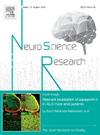Functional analysis of periaqueductal gray neurons projecting to the medulla in active and passive defensive behaviors
IF 2.4
4区 医学
Q3 NEUROSCIENCES
引用次数: 0
Abstract
Fear responses and defensive behaviors are essential for survival. Fear responses are mediated by neural circuits that detect threatening stimuli and classify them as “unpleasant” or “aversive”. These circuits coordinate the selection of defensive behaviors, such as freezing or flight, depending on the perceived imminence of the threat. Activation of excitatory neurons in the lateral/ventrolateral periaqueductal gray (l/vlPAG) induces diverse fear responses, depending on the subregions, projection targets, and stimulation intensity. Some l/vlPAG neurons project to the magnocellular nucleus of the medulla (Mc). However, it remains unclear which of the diverse behaviors arising from different intensities of l/vlPAG stimulation are mediated via the l/vlPAG-Mc pathway. Additionally, the role of the l/vlPAG-Mc pathway activation in driving negative or positive valence-related behavior is unknown. To address these questions, we used optogenetics to stimulate Mc-projecting l/vlPAG neurons at two levels of light intensity and analyzed the resulting behavioral changes. Strong stimulation of Mc-projecting l/vlPAG neurons induced flight behavior, whereas weak stimulation elicited a freezing response. Real-time and conditioned place aversion tests indicated that strong stimulation was aversive. These findings suggest that strong stimulation of Mc-projecting l/vlPAG neurons induces active defensive behavior and behavioral aversion, while weak stimulation induces passive defensive behavior.
主动和被动防御行为中投射到延髓的导水管周围灰色神经元的功能分析
恐惧反应和防御行为是生存所必需的。恐惧反应是由神经回路调节的,神经回路检测到威胁刺激,并将其分类为“不愉快”或“厌恶”。这些回路根据感知到的威胁迫近性来协调防御行为的选择,比如冻结或逃跑。侧/腹外侧导水管周围灰质(l/vlPAG)兴奋性神经元的激活会引起不同的恐惧反应,这取决于亚区、投射目标和刺激强度。一些l/vlPAG神经元投射到髓质的大细胞核(Mc)。然而,目前尚不清楚不同强度的l/vlPAG刺激引起的各种行为中,哪些是通过l/vlPAG- mc途径介导的。此外,l/vlPAG-Mc通路激活在驱动负或正价价相关行为中的作用尚不清楚。为了解决这些问题,我们使用光遗传学方法在两个光强水平下刺激mc -投射l/vlPAG神经元,并分析由此产生的行为变化。强刺激mc - l/vlPAG神经元诱导飞行行为,弱刺激诱导冻结反应。即时和条件厌恶实验表明,强刺激具有厌恶性。这些结果表明,强刺激mc - l/vlPAG神经元可诱导主动防御行为和行为厌恶,弱刺激可诱导被动防御行为。
本文章由计算机程序翻译,如有差异,请以英文原文为准。
求助全文
约1分钟内获得全文
求助全文
来源期刊

Neuroscience Research
医学-神经科学
CiteScore
5.60
自引率
3.40%
发文量
136
审稿时长
28 days
期刊介绍:
The international journal publishing original full-length research articles, short communications, technical notes, and reviews on all aspects of neuroscience
Neuroscience Research is an international journal for high quality articles in all branches of neuroscience, from the molecular to the behavioral levels. The journal is published in collaboration with the Japan Neuroscience Society and is open to all contributors in the world.
 求助内容:
求助内容: 应助结果提醒方式:
应助结果提醒方式:


